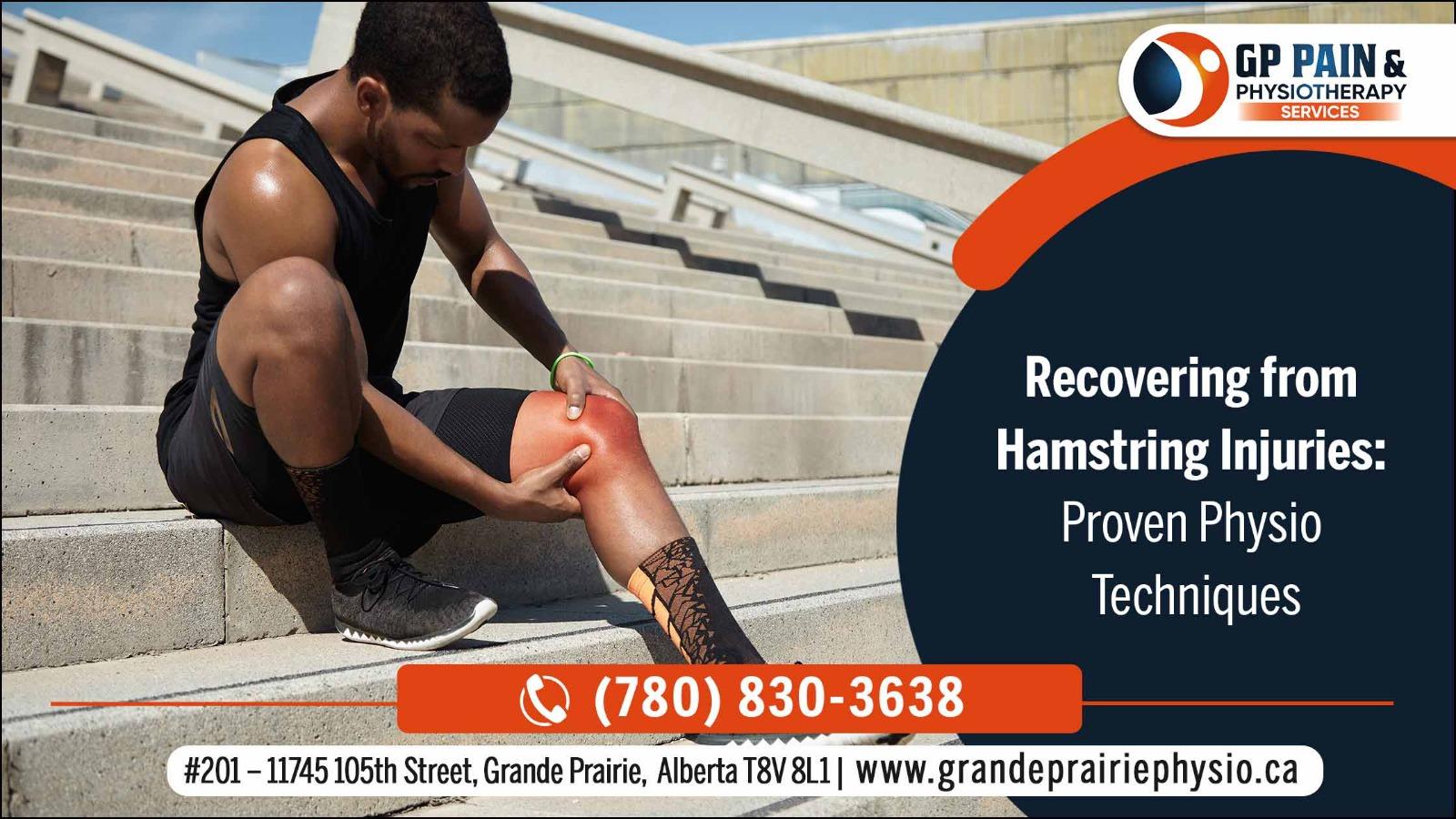Sports physiotherapy emphasizes the assessment and management of musculoskeletal injuries and conditions that occur as a result of sports activities or physical exercise. Sports physiotherapy in Grande Prairie aims to help athletes and individuals involved in physical activities recover from injuries, enhance their performance, and mitigate future injuries.
What are Hamstring Injuries
Hamstring injuries are among the most common injuries affecting athletes, particularly those engaged in sports involving sprinting, jumping, or abrupt changes in direction. The hamstring muscles are situated at the back of the thigh and are composed of three muscles: the semitendinosus, semimembranosus, and biceps femoris. These muscles play a vast role in knee flexion and hip extension, making them essential for activities like running, jumping, and kicking.
Hamstring injuries can range in severity from mild strains to complete tears of the muscle fibres. Symptoms of a hamstring injury may include:
- Sudden onset of pain in the back of the thigh during activity
- Tenderness and swelling in the affected area
- Bruising or discoloration
- Difficulty walking, bending, or straightening the knee
- Weakness or instability in the leg
Proven Physio Techniques for Rehabilitating Hamstring Injuries:
Recovering from hamstring injuries typically involves a comprehensive rehabilitation program designed to promote healing, restore strength and flexibility, and prevent re-injury. Sports injury physiotherapy in Grande Prairie provides a range of specialized services customized to the needs of athletes recovering from hamstring injuries. Here are some proven physiotherapy techniques commonly used in the rehabilitation of hamstring injuries:
Progressive Strengthening Exercises:
Gradual introduction of strengthening exercises targeting the hamstring muscles, such as hamstring curls and bridges, to rebuild muscle strength and endurance. Here are some examples of progressive strengthening exercises commonly used for hamstring injuries:
Isometric Hamstring Contractions:
Isometric exercises involve contracting the muscles without movement. For hamstring injuries, isometric contractions can be performed by pressing the back of the knee against a stable surface while lying down or sitting.
Eccentric Hamstring Curls:
Eccentric exercises involve lengthening the muscle under tension. For hamstring injuries, eccentric hamstring curls are performed by slowly lowering the body while in a prone position with the ankles secured and the knees slightly bent.
Dynamic Stretching:
Incorporating dynamic stretching exercises to improve flexibility and mobility of the hamstring muscles while reducing the risk of re-injury. Here are some examples of dynamic stretching exercises commonly used:
Leg Swings:
- Stand in front of a wall or stable object for support.
- Move one leg forward and backward in a controlled manner, keeping it straight, to dynamically stretch the hamstrings.
- Perform 10-15 swings on each leg.
High Knee Hugs:
- Walk forward while bringing one knee towards the chest and hugging it with both hands.
- Alternate legs while walking, dynamically stretching the hamstrings and activating the hip flexors.
- Perform 10-12 steps forward and backward.
Proprioceptive Neuromuscular Facilitation (PNF):
Utilizing PNF stretching techniques to enhance flexibility, proprioception, and muscle coordination, aiding in the rehabilitation process. Here are some examples of PNF exercises commonly used:
Contract-Relax:
- Lie on your back with one leg extended and the other leg bent.
- Contract the hamstring of the bent leg by pushing against resistance (provided by a partner or a fixed object) for 5-10 seconds.
- Relax and passively stretch the hamstring by gently pulling the leg towards the chest until a mild stretch is felt, holding for 15-30 seconds.
- Repeat this sequence 2-3 times, gradually increasing the stretch intensity.
PNF Spiral Patterns:
- Incorporate diagonal or spiral patterns of movement that involve both the hamstrings and other muscle groups.
- For example, perform diagonal patterns of movement with the arms and legs, actively engaging the hamstrings while moving through the range of motion.
Eccentric Strengthening:
Eccentric exercises, which involve lengthening the muscle under tension, can help improve muscle strength and tendon healing in hamstring injuries. Here are some examples of eccentric strengthening exercises commonly used:
Eccentric Squats:
- Stand with your feet positioned at a distance equivalent to the width of your shoulders and your knees slightly bent.
- Slowly lower into a squat position, emphasizing the eccentric phase by controlling the descent.
- Keep the weight in your heels and maintain a neutral spine throughout the movement.
- Return to the starting position by pushing through the heels and engaging the hamstrings and glutes.
- Perform 3-4 sets of 8-10 repetitions, gradually increasing depth and resistance.
Plyometric Exercises:
The gradual introduction of plyometric exercises to improve muscle power, agility, and neuromuscular control is essential for returning to sports activities. Here are some examples of plyometric exercises commonly used:
Bounding:
- Begin by a standing position with feet hip-width apart.
- Jump forward explosively, driving the knee of the leading leg upward.
- Land on the opposite foot, maintaining balance and control.
- Continue bounding forward, alternating legs with each jump.
- Perform 3-4 sets of 8-10 repetitions, gradually increasing distance and intensity.
Gait Analysis and Correction:
Examine walking and running patterns to pinpoint any biomechanical factors that may be contributing to the injury, then implement corrective strategies. Here are some examples of exercises commonly used in sports physiotherapy in Grande Prairie:
Hip Flexor Stretch:
Tight hip flexors can contribute to altered gait mechanics and increased strain on the hamstrings. Perform hip flexor stretches to improve flexibility and reduce hip flexor tightness.
Glute Strengthening:
Weakness in the gluteal muscles may result in compensatory movement patterns and increased stress on the hamstrings. Incorporate exercises such as bridges, clamshells, and hip thrusts to strengthen the glute muscles.
Empowering Athletes:
GP Pain Physiotherapy in Grande Prairie stands as a vital pillar in the realm of athletic performance and injury management. As athletes strive to push the boundaries of human performance, the role of sports physiotherapists remains indispensable in supporting their endeavours, ensuring they can compete at their best while minimizing the risk of injury and maximizing longevity in their chosen sport. Through continued research, innovation, and collaboration, sports physiotherapy in Grande Prairie will undoubtedly continue to evolve, empowering athletes of every level to reach their utmost potential and thrive in their athletic pursuits.
Read More.. 21 Best Alternatives of Manga Stream to read manga Instantly Best Crazy Games For Childrens How to make selfies with dorian rossini What Happened to Konami The 13 best things to do in the ICELAND 6 Things to Know About Wrongful Death Suits How to increase your customer numbers How to Manipulate Online Slots Know Lab Made Loose Diamonds in Easy Steps 5 Best Winter Fashion Style Tips 5 Best Work From Home tips You should know The 5 Best Budget Friendly Hair Dryers 5 Best Fruit for Babies Diet Methods of Freight Rate Quotes Advantages of Road Freight Understanding Search Engine Optimization in the Competitive Marketplace Tips to Winning Big in Online Casino GPHR Certification Make Your Target Challenges Facing Shippers Transport Top 5 Methods for Online Slots 10 Daily Habits to Keep a House Clean and Tidy Calgary Window Reviews Lux Windows versus Jeld Wen Windows and Doors The Black 411 Announces Plans An Ultimate Guide for CompTIA SK0-005 Exam by Exams4sure List of Few Best Gaming APIs Like Escape from Tarkov, Fortnite API and More How to Get a Used ATV or UTV on the Economical Buying guide for Lighting Reasons Why Regular Website Maintenance Is Important Tips to make your Beauty Beds Last Longer 123Movies Watch Movies Free Online Where to birthday cake order in kohara Finding the Best Freight Shipping Quotes Top 10 Nursing Trends That Will Shape Healthcare Basic Safety Measures For Athletes’ Protection Repair Or Replacement What Does Your Tyre Need VoIP headsets Heads Free Head Set Zone Trending App Ideas for Beginners 8 Reasons to Maintain Up to Date Bookkeeping The best international high schools in Tokyo Japan On Site Rigging Services For The Transportation Industry 5 Ways to Improve Team Communication and Collaboration Why Should You Hire Professional Roofing Contractors in Daytona Beach How To Live A Balanced Lifestyle With Work In Canada Tips to enhance your IGTV Videos Best Furniture For Home in Dubai
Also read about:
How Physiotherapy Can Accelerate Recovery from Common MVA Related Injuries
Best Furniture For Home in Dubai










